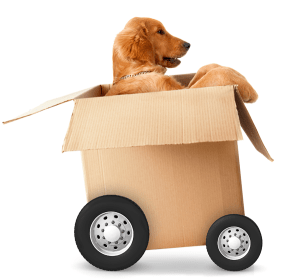You know that moment when you pull out the first moving box and your cat immediately disappears under the bed? Or when your normally friendly dog starts following you from room to room with worried eyes? Here’s the thing – our pets are often the first to sense that something big is happening, and they don’t have the benefit of understanding why their world is suddenly filled with boxes and chaos.
Most people don’t realize that pets can experience the same stress levels during a move as their human family members – sometimes even higher. For rescued pets who may associate upheaval with past abandonment, the anxiety can be particularly intense. Whether you’re moving from Oakland to Berkeley or making a bigger leap across the Bay Area, your animal companions need just as much consideration in your moving plans as selecting the right moving company or packing materials.
We’ve helped thousands of Bay Area families move over the years, and we’ve noticed that the happiest pets (and owners) are those who plan ahead. This guide walks you through everything from pre-move vet visits to helping your pets settle into their new space – because moving is stressful enough without worrying about your four-legged family members.
Before the Move: Setting Your Pet Up for Success
The key to a smooth move with pets starts weeks before the moving truck arrives. We’ve learned that a little preparation goes a long way in reducing stress for everyone involved.
First on the list: scheduling that vet appointment. If your pet requires medication, routine shots, or any other medical attention, take care of it now while you still have easy access to your regular veterinarian. Ask for recommendations for vets in your new area – most veterinarians have networks and can suggest trusted colleagues. Also, get copies of your pet’s complete medical records. You’ll need these when establishing care with a new vet, and having paper copies means you won’t have to worry about records requests during an already busy time.
Here’s something most people overlook: updating your pet’s tags and microchip before the move, not after. We can’t stress this enough. Pets often bolt when they’re scared or agitated, and moving day creates plenty of opportunities for escape. If your pet gets out in your new neighborhood before they know their way around, outdated contact information could mean the difference between a quick reunion and a prolonged search. Update both tags and microchip with your cell phone number (not the landline you’re disconnecting) and consider adding a temporary tag with your new address a few days before the move.
For pets who’ve been through trauma before – particularly rescued animals – the sight of boxes and furniture being moved can trigger memories of past abandonment. These pets need extra reassurance during the packing phase. Keep their routine as normal as possible, maintain regular feeding times, and leave their favorite sleeping spots intact until the last possible moment. Some pet owners find that starting to pack one room at a time, rather than having boxes scattered throughout the house, helps reduce anxiety.
Creating a moving day sanctuary is essential. Clean out one room in your current home ahead of time – a bedroom or bathroom works well. On moving day, this becomes your pet’s safe space, complete with food, water, familiar bedding, and favorite toys. Put a sign on the door reminding movers and helpers that pets are inside. If your pets are particularly anxious, consider using a crate they’re already comfortable with to create an extra sense of security.
Moving Day: Keeping Pets Safe and Calm

The actual moving day presents unique challenges, whether you’re transporting pets yourself or using professional pet transport services. We always recommend that our clients enlist help from family, friends, or professional pet sitters to keep animals away from the action. It’s one less thing to worry about, and it prevents pets from darting out open doors or getting underfoot while heavy items are being moved.
If you’re driving with pets to your new home, preparation is key. Dogs should be secured with proper harnesses or in well-ventilated carriers. Cats should always travel in carriers – even the calmest cat can become unpredictable in a moving vehicle. Pack a pet travel kit with water, bowls, any medications, waste bags, paper towels, and a favorite blanket that smells like home. Plan for stops every 2-3 hours for dogs, and never leave pets alone in the car, especially during Bay Area summers when temperatures can rise quickly.
For those making long-distance moves requiring air travel, contact airlines at least a month in advance. Each airline has different regulations regarding pet transport, required documentation, and carrier specifications. Some require health certificates issued within 10 days of travel. Temperature restrictions often apply – many airlines won’t transport pets if the temperature at any point in the journey exceeds certain limits. Having this information early prevents last-minute scrambles and ensures you can book appropriate flights.
Consider the timing of your pet’s last meal before travel. Most vets recommend feeding a light meal 3-4 hours before departure to prevent motion sickness. Keep water available but monitor intake to reduce the need for bathroom breaks during transport. If your pet has a history of severe travel anxiety, discuss medication options with your vet well before moving day.
Settling In: Helping Pets Adjust to Their New Home
The first 48 hours in your new home set the tone for how quickly your pets will adjust. Start small – don’t give them free run of the entire house immediately. Instead, set up a “home base” in one room with all their familiar items. This gives them a secure space to retreat to while they process all the new smells and sounds.
Once your pets seem comfortable in their initial space (usually after a day or two), begin introducing them to the rest of the house room by room. Walk with them as they explore, offering reassurance and treats. Cats particularly benefit from being shown important locations like litter boxes and feeding areas multiple times. Some cats prefer to explore at night when the house is quiet, so don’t be surprised if your cat hides during the day but emerges after dark to investigate.
Establishing routines quickly helps pets feel secure. Feed them at the same times as in your old home, maintain their usual walking schedule, and try to recreate familiar arrangements – if their bed was near a window before, find a similar spot in the new house. The faster you can establish normalcy, the quicker they’ll settle in.
For dogs, short walks around your new neighborhood serve double duty. They help your dog become familiar with the area while also giving you a chance to meet neighbors and other dog owners. Keep these initial walks short and positive, gradually expanding the territory as your dog becomes more confident. Always keep them leashed until you’re certain they know their way home.
Watch for signs that your pet is struggling with the adjustment. Some anxiety is normal – hiding, decreased appetite for a day or two, or extra clinginess are common reactions. However, if symptoms persist beyond a week, if your pet stops eating entirely, or if you notice aggressive behavior, destructive habits, or house-training regression, it may be time to consult with a veterinarian or animal behaviorist.
Finding Pet Services in Your New Bay Area Neighborhood
Part of helping pets settle in involves establishing new care relationships. If your previous vet didn’t have specific recommendations, start your search by asking new neighbors for referrals. Local community Facebook groups, Nextdoor, and neighborhood apps often have extensive discussions about trusted veterinarians, groomers, and pet sitters.
When meeting potential new vets, don’t just consider location and pricing. Look for a practice that matches your pet’s needs – some animals do better in smaller, quieter clinics, while others might benefit from larger facilities with extended hours. Schedule meet-and-greet appointments at a couple of clinics before making your choice. This lets you evaluate the staff, cleanliness, and overall environment without the pressure of an actual medical appointment.
Beyond veterinary care, research local pet resources specific to your new area. Dog parks in Berkeley have different rules than those in San Francisco. Walnut Creek has extensive walking trails, while Oakland offers various pet-friendly cafes and shops. Learning what’s available helps you maintain your pet’s activity level and social needs, which aids in the adjustment process.
Key Takeaways
Moving with pets requires planning, patience, and understanding. The most important points to remember:
- Update identification and microchips before moving day, not after
- Create safe spaces during both packing and moving phases
- Introduce pets to their new home gradually
- Establish familiar routines as quickly as possible
- Monitor for adjustment issues and seek help if needed
Your pets depend on you to guide them through this transition. By seeing the move through their eyes and taking steps to reduce their anxiety, you’re setting everyone up for a smoother experience.

Making Your Move Easier on Everyone
At Jay’s Small Moves, we understand that pets are family members who need special consideration during a move. We’ve helped countless Bay Area families navigate moves with everything from nervous cats to anxious dogs to the occasional rabbit or bird. Our teams know how to work quietly and efficiently, minimizing disruption to your pets’ routine.
If you’re planning a move with pets, we’d be happy to discuss strategies that have worked for other families in similar situations. Whether you need full-service moving support or just help with the heavy lifting while you handle pet transport, we can customize our services to meet your needs. Give us a call at (510) 501-5800 to talk through your options – because the best moves are the ones where every family member, two-legged or four-legged, arrives safely and stress-free at their new home.

